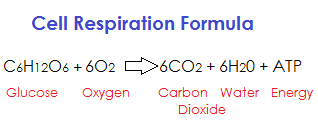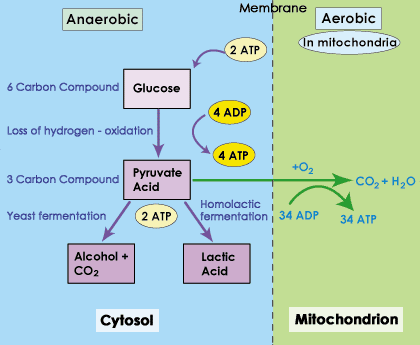12.02 Aerobic Respiration
Aerobic Respiration
- Aerobic respiration is a metabolic process that cells use to convert organic molecules into usable energy in the form of ATP.
Definition of Respiration
- Respiration is the process by which cells break down organic molecules to release energy, which is then used to synthesize ATP.
- Primary Substrate:
- Glucose is the main substrate used in aerobic respiration.
- Alternative Substrates: Cells can also utilize fatty acids, glycerol, and amino acids depending on availability and cell type.
- Examples:
- Brain Cells: Primarily use glucose for energy.
- Heart Muscle Cells: Often prefer fatty acids as their energy source.

Stages of Aerobic Respiration
- Aerobic respiration consists of four main stages, each occurring in specific cellular locations and serving distinct functions.
- Glycolysis
- Location: Cytoplasm
- Function:
- Initial breakdown of one glucose molecule into two molecules of pyruvate.
- Produces a net gain of 2 ATP molecules and 2 NADH molecules.
- Key Points:
- Does not require oxygen.
- Converts glucose (6 carbons) into two pyruvate molecules (3 carbons each).
- Link Reaction (Pyruvate Decarboxylation)
- Location: Mitochondrial Matrix
- Function:
- Converts pyruvate into acetyl-CoA.
- Releases one molecule of CO₂ per pyruvate.
- Produces one NADH per pyruvate.
- Key Points:
- Prepares pyruvate for entry into the Krebs Cycle.
- Links glycolysis to the Krebs Cycle.
- Krebs Cycle (Citric Acid Cycle)
- Location: Mitochondrial Matrix
- Function:
- Completes the oxidation of acetyl-CoA.
- Generates 2 ATP molecules per glucose molecule.
- Produces 6 NADH and 2 FADH₂ molecules per glucose.
- Releases 4 molecules of CO₂ per glucose.
- Key Points:
- Each acetyl-CoA enters the cycle and combines with oxaloacetate to form citrate.
- Multiple enzymatic steps regenerate oxaloacetate.
- Oxidative Phosphorylation
- Location: Mitochondrial Inner Membrane
- Function:
- Uses energy from NADH and FADH₂ to synthesize ATP via the electron transport chain and chemiosmosis.
- Generates approximately 28-34 ATP molecules per glucose.
- Key Points:
- Electron Transport Chain (ETC): Electrons from NADH and FADH₂ pass through a series of proteins, releasing energy to pump hydrogen ions into the intermembrane space.
- Chemiosmosis: Hydrogen ions flow back into the mitochondrial matrix through ATP synthase, driving the production of ATP.
Aerobic vs. Anaerobic Pathways
- Understanding the differences between these pathways is crucial for comprehending how cells generate energy under varying conditions.

- Aerobic Respiration
- Involves: All four stages (Glycolysis, Link Reaction, Krebs Cycle, Oxidative Phosphorylation).
- Location: Mitochondria.
- Oxygen Requirement: Requires oxygen as the final electron acceptor in the ETC.
- ATP Yield: High (approximately 30-38 ATP per glucose).
- Anaerobic Respiration
- Involves: Only Glycolysis and fermentation pathways.
- Location: Cytoplasm.
- Oxygen Requirement: Does not require oxygen.
- End Products:
- In Animals: Lactate (lactic acid).
- In Yeast and Some Bacteria: Ethanol and CO₂.
- ATP Yield: Low (2 ATP per glucose).
Key Terms
- Substrate-Level Phosphorylation:
- Direct formation of ATP by transferring a phosphate group from a substrate to ADP.
- Chemiosmosis:
- ATP synthesis powered by the movement of hydrogen ions across a membrane, driven by the electron transport chain.
- Acetyl-CoA:
- A molecule that participates in many biochemical reactions in protein, carbohydrate, and lipid metabolism, entering the Krebs Cycle.
- NADH and FADH₂:
- Electron carriers that transport electrons to the electron transport chain for ATP production.
Figure A: Overview of Aerobic Respiration

- Glycolysis (Cytoplasm)
- Glucose → 2 Pyruvate + 2 ATP + 2 NADH
- Link Reaction (Mitochondria)
- 2 Pyruvate → 2 Acetyl-CoA + 2 CO₂ + 2 NADH
- Krebs Cycle (Mitochondria)
- 2 Acetyl-CoA → 4 CO₂ + 2 ATP + 6 NADH + 2 FADH₂
- Oxidative Phosphorylation (Mitochondrial Inner Membrane)
- NADH and FADH₂ → ATP via Electron Transport Chain and Chemiosmosis
Highlight the difference between aerobic (mitochondrial) and anaerobic (cytoplasmic) pathways.

Discussion Questions
- Equation for ATP Formation:
- Reaction: ADP + Pi → ATP + H₂O
- Energy Currency:
- Discussion Point: Explain why ATP is referred to as the “energy currency” of the cell.
- Analogy: Just as money is exchanged to perform transactions, ATP is exchanged to transfer energy for various cellular processes.
Practice Questions
Question 1
Define aerobic respiration and explain its primary purpose in the cell.
Marking Scheme:
- Definition of Aerobic Respiration (2 marks)
- Aerobic respiration is a metabolic process that cells use to convert organic molecules into usable energy in the form of ATP.
- Primary Purpose (3 marks)
- The primary purpose of aerobic respiration is to break down organic molecules, primarily glucose, to release energy.
- This energy is then used to synthesize ATP, which serves as the main energy currency for various cellular processes.
- Keywords to Include:
- Metabolic process, organic molecules, ATP, energy, glucose.
Total Marks: 5
Question 2
List the four main stages of aerobic respiration and briefly state the primary function of each stage.
Marking Scheme:
- Listing the Four Stages (4 marks)
- Glycolysis
- Link Reaction (Pyruvate Decarboxylation)
- Krebs Cycle (Citric Acid Cycle)
- Oxidative Phosphorylation
- Primary Function of Each Stage (4 marks; 1 mark per stage)
- Glycolysis: Initial breakdown of glucose into pyruvate, producing ATP and NADH.
- Link Reaction: Converts pyruvate into acetyl-CoA, releasing CO₂ and producing NADH.
- Krebs Cycle: Completes the oxidation of acetyl-CoA, generating ATP, NADH, FADH₂, and releasing CO₂.
- Oxidative Phosphorylation: Uses NADH and FADH₂ to produce a large amount of ATP via the electron transport chain and chemiosmosis.
- Keywords to Include:
- Glycolysis, Link Reaction, Krebs Cycle, Oxidative Phosphorylation, ATP, NADH, FADH₂, electron transport chain, chemiosmosis.
Total Marks: 8
Question 3
Compare and contrast aerobic and anaerobic respiration in terms of oxygen requirement and ATP yield.
Marking Scheme:
- Aerobic Respiration:
- Oxygen Requirement: Requires oxygen as the final electron acceptor in the electron transport chain. (1 mark)
- ATP Yield: High ATP yield, approximately 30-38 ATP per glucose molecule. (1 mark)
- Anaerobic Respiration:
- Oxygen Requirement: Does not require oxygen. (1 mark)
- ATP Yield: Low ATP yield, only 2 ATP per glucose molecule. (1 mark)
- Comparison and Contrast:
- Highlight that aerobic respiration involves all four stages (Glycolysis, Link Reaction, Krebs Cycle, Oxidative Phosphorylation) and occurs in the mitochondria.
- Anaerobic respiration involves only Glycolysis and fermentation pathways and occurs in the cytoplasm. (2 marks)
- Keywords to Include:
- Oxygen requirement, ATP yield, aerobic vs. anaerobic, electron transport chain, glycolysis, mitochondria, cytoplasm.
Total Marks: 6
Question 4
Explain the role of glucose in aerobic respiration and name two alternative substrates that cells can use.
Marking Scheme:
- Role of Glucose:
- Glucose is the primary substrate used in aerobic respiration.
- It is broken down during glycolysis to produce pyruvate, ATP, and NADH, initiating the process of energy extraction. (2 marks)
- Alternative Substrates:
- Fatty acids
- Glycerol
- Amino acids (any two) (2 marks)
- Additional Points:
- The choice of substrate depends on availability and cell type.
- Example: Heart muscle cells often prefer fatty acids as their energy source. (1 mark)
- Keywords to Include:
- Glucose, primary substrate, fatty acids, glycerol, amino acids, energy source.
Total Marks: 5
Question 5
Describe the process of glycolysis, including its location, inputs, and products.
Marking Scheme:
- Location:
- Glycolysis occurs in the cytoplasm of the cell. (1 mark)
- Inputs:
- One molecule of glucose (6 carbons). (1 mark)
- Process:
- Glucose is broken down into two molecules of pyruvate (3 carbons each). (1 mark)
- Products:
- Net gain of 2 ATP molecules.
- 2 NADH molecules. (2 marks)
- Key Points:
- Does not require oxygen (anaerobic process).
- Converts glucose into pyruvate, preparing it for further stages of respiration. (1 mark)
- Keywords to Include:
- Glycolysis, cytoplasm, glucose, pyruvate, ATP, NADH, anaerobic.
Total Marks: 6
Question 6
What is the function of the electron transport chain (ETC) in oxidative phosphorylation?
Marking Scheme:
- Function of ETC:
- Electrons from NADH and FADH₂ are passed through a series of proteins in the mitochondrial inner membrane. (1 mark)
- As electrons move through the ETC, energy is released to pump hydrogen ions (protons) into the intermembrane space, creating a proton gradient. (2 marks)
- This proton gradient is essential for the process of chemiosmosis, which drives the synthesis of ATP via ATP synthase. (2 marks)
- Overall Role:
- ETC facilitates the transfer of electrons and the generation of a proton gradient necessary for ATP production. (1 mark)
- Keywords to Include:
- Electron Transport Chain, oxidative phosphorylation, NADH, FADH₂, mitochondrial inner membrane, proton gradient, ATP synthase.
Total Marks: 6
Question 7
Why is ATP referred to as the “energy currency” of the cell? Provide one analogy to support your explanation.
Marking Scheme:
- Explanation:
- ATP is called the “energy currency” because it stores and transfers energy within the cell, similar to how money is used to conduct transactions in an economy. (2 marks)
- Analogy:
- Just as money is exchanged to perform transactions, ATP is exchanged to transfer energy for various cellular processes, such as muscle contraction, active transport, and biosynthesis. (2 marks)
- Additional Point:
- ATP hydrolysis provides immediate energy where and when it is needed, ensuring efficient energy usage within the cell. (1 mark)
- Keywords to Include:
- Energy currency, ATP, energy transfer, analogy, transactions, cellular processes.
Total Marks: 5
Question 8
Compare the ATP yield from glycolysis and oxidative phosphorylation. Why is oxidative phosphorylation more efficient?
Marking Scheme:
- ATP Yield:
- Glycolysis produces a net gain of 2 ATP molecules per glucose molecule. (1 mark)
- Oxidative phosphorylation generates approximately 28-34 ATP molecules per glucose molecule. (1 mark)
- Efficiency of Oxidative Phosphorylation:
- Oxidative phosphorylation is more efficient because it utilizes the high-energy electrons from NADH and FADH₂ to produce a large amount of ATP via the electron transport chain and chemiosmosis. (2 marks)
- The proton gradient created by the ETC allows ATP synthase to produce ATP continuously and efficiently. (2 marks)
- Keywords to Include:
- ATP yield, glycolysis, oxidative phosphorylation, electron transport chain, chemiosmosis, efficiency.
Total Marks: 6
Question 9
What are NADH and FADH₂, and what role do they play in aerobic respiration?
Marking Scheme:
- Definition:
- NADH and FADH₂ are electron carriers. (1 mark)
- Role in Aerobic Respiration:
- They transport high-energy electrons to the electron transport chain in the mitochondrial inner membrane. (2 marks)
- As electrons pass through the ETC, their energy is used to pump hydrogen ions, creating a proton gradient. (2 marks)
- This proton gradient drives the synthesis of ATP via chemiosmosis. (1 mark)
- Additional Points:
- NADH is produced during glycolysis, the link reaction, and the Krebs cycle.
- FADH₂ is produced during the Krebs cycle. (1 mark)
- Keywords to Include:
- NADH, FADH₂, electron carriers, electron transport chain, proton gradient, ATP synthesis, chemiosmosis.
Total Marks: 7
Question 10
Explain why cells cannot store large quantities of ATP and how they compensate for this limitation.
Marking Scheme:
- Inability to Store ATP:
- ATP is unstable and cannot be stored in large quantities within the cell. (1 mark)
- Cells require a constant supply of ATP to meet their immediate energy needs. (1 mark)
- Compensation Mechanism:
- Cells continuously synthesize ATP through processes like substrate-level phosphorylation and chemiosmosis during cellular respiration. (2 marks)
- This ensures a steady availability of ATP to fuel various cellular activities. (1 mark)
- Additional Points:
- Approximately 50 kg of ATP is used daily by human cells, highlighting the necessity for continuous ATP production. (1 mark)
- Keywords to Include:
- ATP storage, instability, continuous synthesis, substrate-level phosphorylation, chemiosmosis, cellular respiration.
Total Marks: 6